Bobby Zokaites: In His Own Words
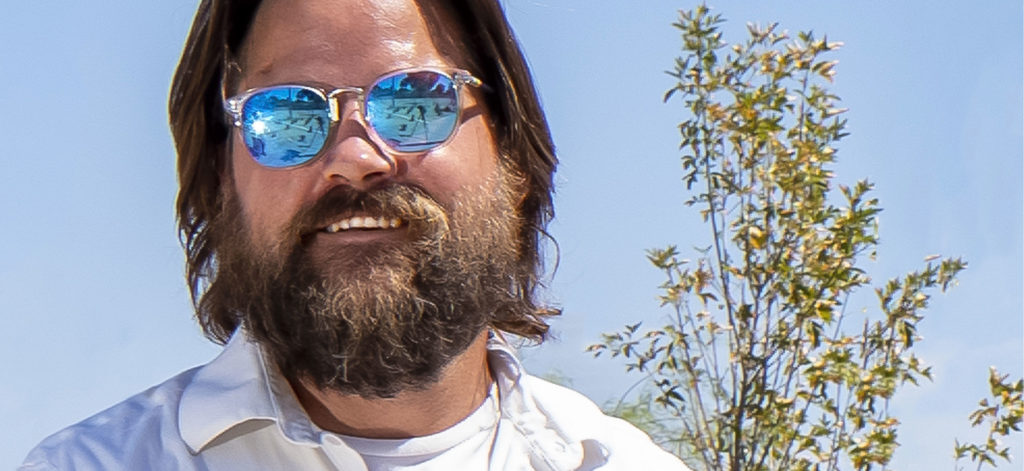
Apr, 20, 2021
ArtistsCommunityPhxArtist Spotlight
Bobby Zokaites: In His Own Words
Local sculptor Bobby Zokaites rejects the traditional convention of art as a hands-free experience, tossing it all the way out the door. Instead, he channels his enthusiasm about the idea of play to create large-scale, interactive objects and spaces that spark audience interaction. Yes—that means you can touch, climb, and even bounce on his sculptures (as the work permits).
In recent years, Zokaites has produced public artworks for spaces across the United States, drawing from his love of adventure and fabrication to create works that re-imagine the relationships between viewer, artist, performer, artwork, and space. We spoke with Zokaites to learn about his first inspirations, how his work reflects and drives a sense of community, and the projects he’s working on around the Valley of the Sun that inspire a sense of play in all of us.
Here’s Bobby Zokaites, in his own words.
“My process for creating public art often begins by identifying what moves or excites a neighborhood by tuning into the emotional cues within residents’ storytelling.”
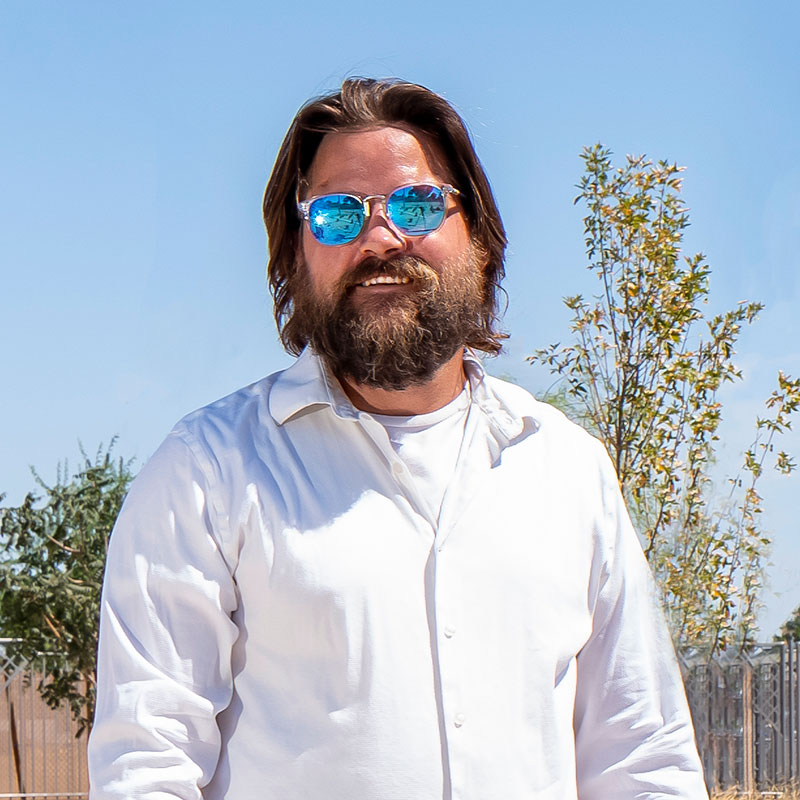
Photo Credit: Grey Shed Studio.
PhxArt: Tell us about where you’re from and what first inspired you to become a sculptor.
Bobby Zokaites: I grew up in a small town in Southwest Virginia, in the middle of the Blue Ridge Mountains. My parents met at Virginia Tech through the caving club there. My dad became an electrical engineer, my mom an environmental activist and educator. Throughout their careers and throughout parenthood, they sustained an adventurism that gave my two brothers and me a very unique upbringing. We spent the majority of our time outdoors and in caves, which instilled in us a sense of self-reliance, the importance of community contribution, and some of that Appalachian ingenuity.
I learned many of the skills and thought experiments that I still use today at a very young age. A favorite and illustrative anecdote is about the carbide lamps that were our primary sources of light underground; these are the old miners’ lamps that use a mineral combined with water to produce an acetylene flame. Because we relied on these lamps, we regularly practiced cleaning and rebuilding them blind-folded. This visualization exercise forced us to think about where specific parts go, and for me, as a sculptor, it has evolved into a very useful skill to have.
If we go even a little further back, both of my grandfathers were engaged in building practices, one as an architect and one as a vocational school teacher. From them, my parents gained the confidence they needed to build their own addition on our childhood home—which was one hell of an introduction to tools and building! We learned skills that helped us build tree houses and castle turrets, and by the time I was 14, the three of us had reroofed the house. My parents were laying the foundation for me to develop that same confidence my grandparents had fostered for them.
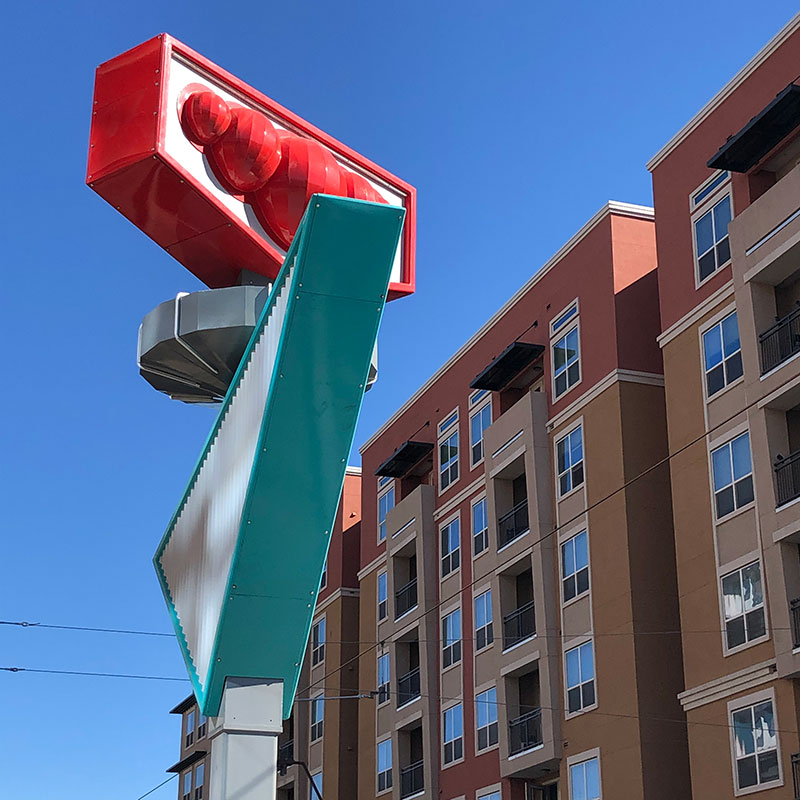
Bobby Zokaites, Tempe Streetcar – Sign Remix, 2020. Steel, automotive paint, NeonFlex lighting. Photo credit: Zokaites Sculpture.
PhxArt: What are the media you prefer to work with, and what do you like to explore through your work?
Zokaites: I call myself a sculptor, which means that I specialize in material and fetishize process. I work with metals, woods, and other industrial materials. I’ve run foundry classes and am weld certified. I also often sew and weave with much lighter materials like fabric, rope, and paracord. I find pleasure in allowing materials to take their own shape and combinations to dictate form and line. My personal satisfaction is in the making of something new, something that did not exist and has no name.
Making, for me, is about exploration, an attempt to change reality to create new experiences and share those experiences. My 2015 work Shifting Sand Land, commissioned by and made in collaboration with the Scottsdale Arts Festival, is a great example of that. Named after a desert level in the video game world of Super Mario Brothers, this artwork is an all-ages version of the classic game “Can’t Touch the Ground.” Dozens of small platforms cluster to create a 50’ archipelago that provides an alien landscape ripe for exploration. The hemispherical foundations of these “islands” constantly change the center of gravity— keeping participants on their toes! It was very gratifying to see all of the games that were invented because of the diversity of participation, and especially to watch kids teaching their parents and grandparents how to play.

Bobby Zokaites, Shifting Sand Land, 2015. Steel, wood, and upholstery fabric. Photo credit: Scottsdale Public Art.
PhxArt: Why is it important that people play with and physically interact with your public artworks? Why this departure from the idea that art is meant to be looked at but not touched?
Zokaites: Many of my own formative experiences have occurred in community, during very physical activity or shared labors. While the focus was mostly on the task at hand—building a barn, erecting a sculpture, or hiking many miles through rough terrain—what lasted really came from everything that happened in proximity to those undertakings: the way the groups set goals and made decisions, how we envisioned outcomes and pathways, an engrained understanding that we were stronger together and that collaboration could be practical, sensical, easy, and enjoyed. Each were acts of collective imagination and a very positive reward.
I’ve been interested in recreating spaces like these, extracting this framework from what are maybe more niche endeavors and bringing it into the public square through concepts of play. My process for creating public art often begins by identifying what moves or excites a neighborhood by tuning into the emotional cues within residents’ storytelling. As an example, A Time Machine Called Tinaja transformed a single students’ resonant and poignant reflection on the local experience into civic design that will exist beyond both our lifetimes.
It’s my hope that as more of the world’s population moves into cities, welcoming and accessible sites for connection, interaction, play, exploration, and imagination constructed with specific communities will become increasingly significant as both markers of the unique character of neighborhoods and of the expertise-of-place possessed by residents. Articulating the voice and vision of a community in a sculptural aesthetic that is big, bold, colorful, and enduring feels like a beacon of that sense of hope.
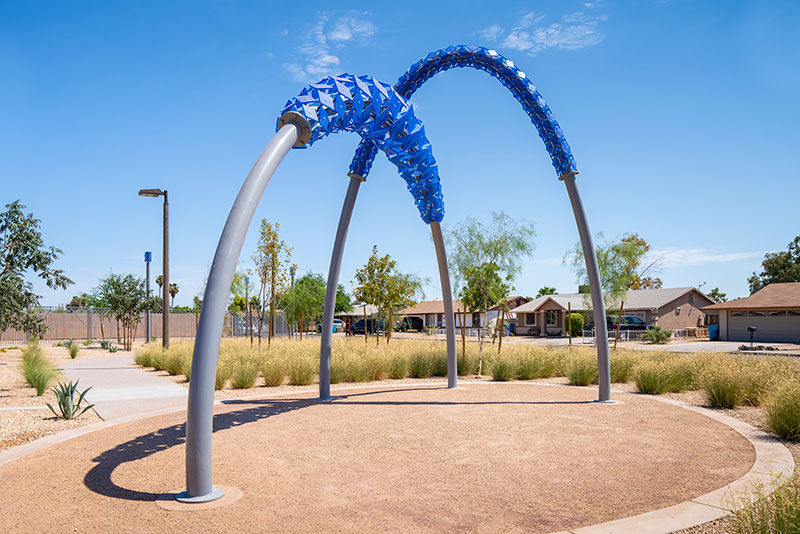
Bobby Zokaites, A Time Machine Called Tinaja – Central Sculpture, 2020. Steel, polyurethane, LEDs, concrete, native plantings. Photo credit: Grey Shed Studio.
PhxArt: Who are your greatest artistic influences?
Zokaites: I was trained in western New York at Alfred University. While I spent most of my time in the foundry, I also received a minor in art history, drawn especially to the philosophies and practices of Barbara Hepworth, Isamu Noguchi, and Constantin Brâncuși, as well as to both the gravity and humor of the Bauhaus (especially Schlemmer) and the Dadaists. The faculty at Alfred are incredibly dedicated to their students and their own work. While I am grateful to all of those who had an impact on me, it was Diane Cox, Coral Lambert, and Angie To who had the biggest impact on my early learning. Diane’s and Coral’s energies are beyond limits, their ability to inspire work and thought unmatched. Angie’s ability to explain concepts is concise and direct. I will also say that the peers I was trained with are amazing people; that community still inspires me today.
I then spent three years in Minnesota at Franconia Sculpture Park (FSP) before moving to Arizona. There I met countless numbers of sculptors, including John Hock, Peter Morales, Jeffery Kalstrom, Bridget Beck, and Paul Howe, to name just a few. In that time, I was able to see many different materials transmute through raw ambition and many different working methodologies, with regular nods to back-to-the-landers like Alice Aycock and Michael Heizer. It is my experience at FSP that gives me confidence to experiment for no other reason than personal growth.
In graduate school at Arizona State University, I brought these experiences together around the ideals of “participation.” I was still thinking about Noguchi but circled back to his voluntary internment in World War II to run a woodshop in the camp. I also thought about Oppenheimer and his hand in both the refinement of the uranium that tragically enabled the bombing of Hiroshima as well as his later founding of the Exploratorium, a museum for art, science, and human perception; Mark Twain’s contributions to Nevada’s Gold Rush-era newspaper featuring stories and witticisms on frontier life; and more. My bookshelves have always been full of the stories that imagine worlds and societies and describe the physical and intangible shapes and decisions that seed them, from the fantasy worlds of Tolkien and Herbert to the hopeful biographies of the Obamas. The shapes of these worlds are determined by the agency of their societies and the most active civic participants. This premise is also espoused by post-war architects like Waldo Van Eyck and artists like Christo and Jean-Claude, who brought their own active participation to bear in public dialogues and community-driven processes of creation. My thesis work became as much about the community that was engaged in its creation as it was about the installation itself.
After graduating, I traveled and worked throughout the U.S. before returning back to Arizona to formally establish my studio. Here, I’ve found my community in people like Zach Valent, Haylee Bolinger, Kara Roschi, Peter Bugg, David Adams, Nick Rascona…there are so many. I’ve also found mentors in Mary Neubauer, Mary Lucking, and Chico MacMurtrie.
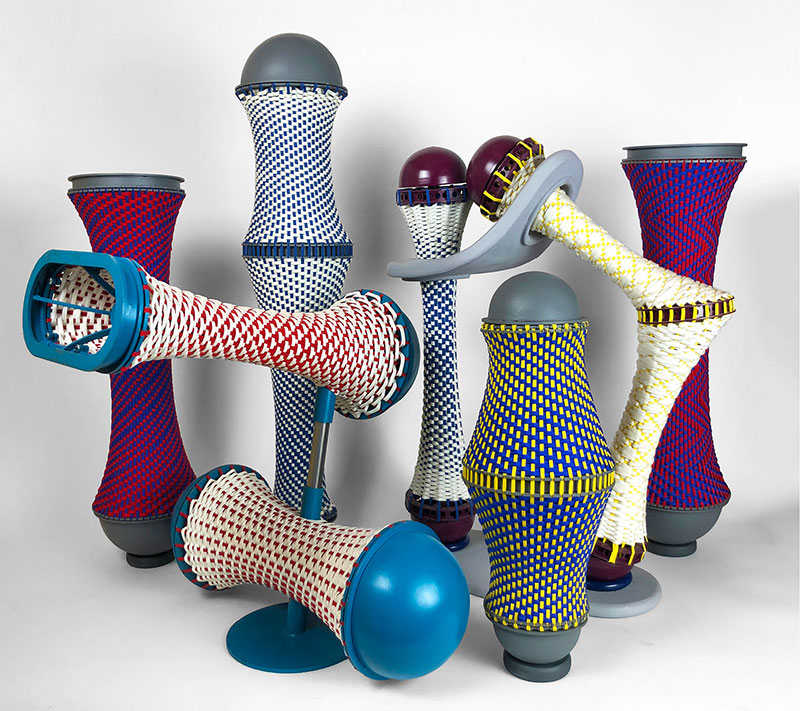
Bobby Zokaites, Weavings – Weaving Group, 2020. Custom steel looms and paracord. Photo credit: Zokaites Sculpture.
PhxArt: What are some works or series you’re currently working on or have recently exhibited?
Zokaites: I recently completed two major public art projects—works of permanent civic infrastructure—in Phoenix and Tempe. One is a new greenspace park in a residential Maryvale neighborhood, and the other consists of three large-scale sculptural installations for a Valley Metro Light Rail expansion project.
For A Time Machine Called Tinaja, landscape architects from Dig Studio and I transformed a City of Phoenix water-well site at North 73rd Avenue and Crittenden Lane into a new community greenspace. Developed through a partnership between the City’s Water Services Department and Office of Arts and Culture Public Art Program, the project turned a large vacant lot surrounded by chain-link fence into a community space with walking paths, sculpture, fencing, lighting, and landscaping. Our design team drew inspiration for the enhancements from the history of the area, meetings with neighbors and hosting school workshops with more than 100 students at nearby Trevor G. Browne High School.
The central sculptures mimic the look and feel of water. Two steel and polyurethane arches, 16’ and 19’ tall, provide a luminescent blue landmark and passage for students walking to and from the nearby middle school and high school. Dig Studio arranged the site’s rows of native desert trees and other resilient botanicals in sections and rows to symbolize the area’s agricultural history and help to reduce the impact of urban heat. At night, the site’s illuminated sculpture, paths, and fences brighten a formerly dark stretch of North 73rd Avenue. The project title refers to small natural pockets of water that sit atop the Sonoran desert floor and serve as welcome respite for desert travelers—an apt description for this newly beautified Maryvale well site.
Then, expected to open in 2021, the Tempe Streetcar is a highly-anticipated Light Rail expansion project in the heart of downtown Tempe. I was selected to design, fabricate, and install sculptures at three stops along Apache Boulevard. Each installation brings together elements of the community, the site, local history, and the natural environment.
Superbloom at Paseo Del Saber features 10 custom luminaries mounted to five antique light posts salvaged from city storage. Nestled within university architecture similarly named for desert botanicals, this artwork is a colorful abstraction of the valley’s famous wildflower superblooms. Apache Boulevard, with its rich history of iconic signage, has remained a bellwether landscape for the continuous flux between university and city architecture. In honor of this tradition, Sign Remix at the Rural Road stop blends historical signage with space-age materials. And finally, for An Antonym for a Tchotchke, abstracted air handlers on high perches overlook the streetcar stop at Dorsey Road. The contemporary presentation of seemingly arcane items reminds viewers that Tempe is not only built around the industry of the college but also thrives due to its other histories of manufacturing and industry.
PhxArt: What can our community expect to see next from you?
Zokaites: Throughout recent years-long commitments to public art projects, an ongoing experimental studio practice has provided a haven for the exploration of new technologies, materials, and forms. I regularly return to drawing and to fabric, rope, wood, tie wire, and paracord to hash out certain fundamentals, and the last many months have delivered a number of breakthroughs.
As a sculptor, I’ve been weaving as a solution for sculptural skins for 15 years, continuously testing the craft’s pliancy of scale. I’ve constructed weavings of an intimate size—tabletop maquettes with paracord—that have scaled up to being 20’ long with the use of industrial discards like sunshade fabric and seatbelt webbing. I’ve also used the material vernacular of permanent public art, steel, and polyurethane to create durable, large-scale, outdoor forms reminiscent of weavings.
With many of us spending more time at home, in domestic space, I’ve been drawn to work at a more intimate and tactile scale and to deepen my research and experience in the details and problems of weaving in the round, exploring the nuances of tension and patterning. Research and work sessions with a local cohort of peer practitioners have heightened the enjoyment of the process and greatly improved the results. These sculptural investigations have led to innovative loom constructions and a greater complexity in the weave patterning, creating a new formal architecture. Increased access to industrial materials and processes combined with this deeper and more dedicated study of traditional craft methodologies have yielded a new suite of experimental works that I am excited to exhibit in the future.
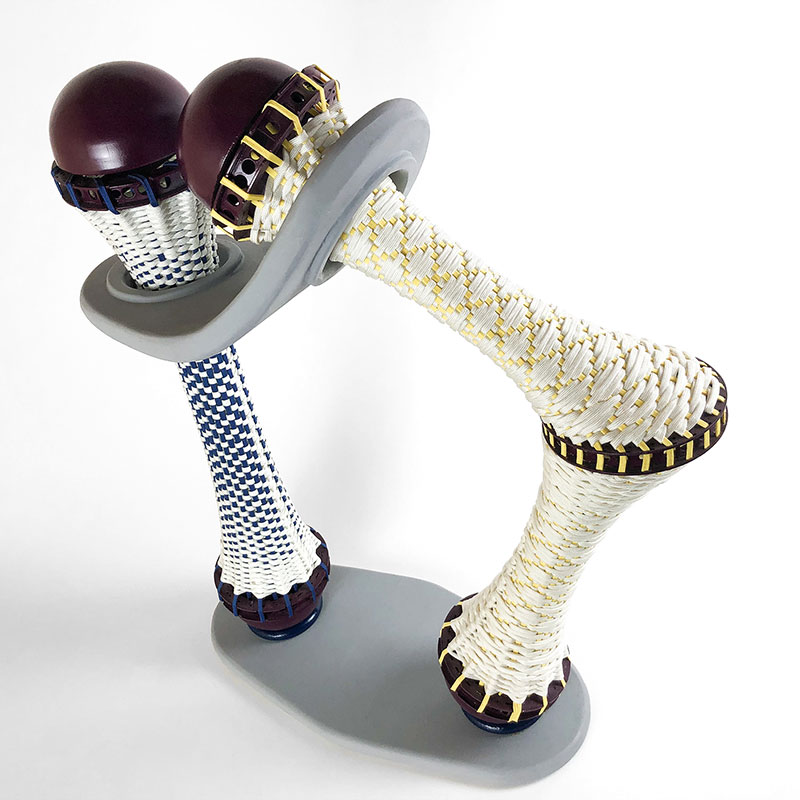
Bobby Zokaites, Weavings – Blend, 2020. Steel, paracord, wood. Photo credit: Zokaites Sculpture.
SEE MORE
To see more work by Bobby Zokaites, visit www.bobbyzokaites.com, follow him on Instagram @bobbyzokaites, or find him on LinkedIn. For commission inquiries, email zokaitessculpture@gmail.com.
#CreativeQuarantine
We’re curious how creatives are navigating the time of coronavirus. Bobby Zokaites shares what’s giving him life as a creative during quarantine.
Zokaites: I went full-time for myself in 2016 and started building a studio in my backyard in 2017. I consider the human element of a studio to be more important than the physical infrastructure, and because of that ideal, the studio is and has always been intended to be a shared one. This is to say that last spring, I was already working from home.
My studio-mates became even more present in the shared space as many of their 9-5s went remote. Studio intern Emery Hall spent this time here as well, in our studio pod, during her last semester at ASU and through the summer, working full-time with me on completing the two major city infrastructure projects that were on our plate.
Chico MacMurtrie, who is normally based in New York City and works worldwide, uses his childhood home in Bisbee as a manufacturing site and through the pandemic has been building out his own large studio space there. I have spent much of my time this winter helping with that project. While I’ve been missing all of the art shows and events that help me connect with audiences and other artists, being able to spend this time focusing on and in the studio, and its own pocket community, has been generative.
And, more recreationally, one thing the pandemic didn’t put a damper on is the great outdoors. When not at home or in the studio, I’ve made a concerted effort to be out in the parks, scrabbling up mountainsides, repelling into canyons, and hiking through some of the most surreal landscapes within driving distance. These extraordinary experiences not only inform my sculpture practice but also stir those senses of excitement, curiosity, and adventure that motivate me.
Categories
What can we help you find?
Need further assistance?
Please call Visitor Services at 602.257.1880 or email